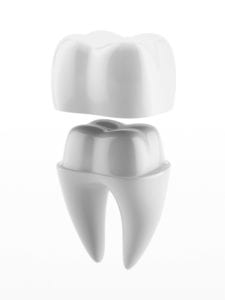Why Do I Need a Temporary Restoration?

Did you know that two dental appointments are needed to place indirect restorations? An indirect dental restoration refers to any restoration that must be fabricated outside the mouth using a dental laboratory. Examples of indirect restorations include: crowns, bridges, inlays, onlays, and veneers. Due to the time it takes to produce a customized dental restoration, indirect restorations require some time between obtaining the fabrication information and placing the permanent restoration.

At your first dental appointment, your dentist will prepare the affected tooth or teeth to accommodate the specific type of restoration you’re having placed. Then, they will take a dental impression or oral scan of your mouth that is sent to a dental lab. The dental lab uses this information to create a customized restoration that will fit perfectly, while matching the size, shape, and color of the surrounding teeth.
However, since your natural tooth structure has been modified to make room for the restoration, your dentist will place a temporary restoration for you to wear until the permanent restoration has arrived. Temporary restorations are important for several reasons, including:
Maintain Space
When something with one or more teeth changes, the other teeth will change slightly to adapt to the change. For example, the surrounding teeth will often shift to fill a gap left by missing teeth. However, if you are having a bridge placed to replace a missing tooth, this shifting can cause the bridge to not fit properly. In these cases, a temporary restoration is used to maintain the necessary amount of space so the permanent restoration fits seamlessly.
Maintain Gum Contour
It is also important to maintain the natural contour of your gum line so that your permanent restoration will have a natural appearance. When a tooth changes in size or shape, the gum contour will also change slightly. However, a temporary restoration maintains the current gum contour so the gums will fit around the permanent restoration properly.
Maintain Eating and Speaking Ability
From a linguistic standpoint, any structural changes made to the teeth can affect the airflow associated with speech. Changing the size or shape of your teeth can also make it difficult to chew or bite. Using a temporary restoration allows you to maintain the ability to speak and eat properly.

Protection
To prepare for a dental restoration, your dentist will modify the shape and/or size of your tooth in order to allow the restoration to fit properly. As a result, parts of the enamel may be removed and the underlying dentin layer may be exposed. Not only can this cause tooth sensitivity, but it can also increase the risk of developing cavities or a pulp infection. For these reasons, a temporary restoration is placed as a way of protecting the tooth.
Preview Results
One of the most exciting parts about having a temporary restoration is the simple fact that it allows you to preview the look, fit, and comfort of your permanent restoration. It is important to note, however, that while modern temporary restorations are more aesthetic than ever, your permanent restoration will likely be aesthetically superior.
As you can see, having a temporary restoration placed is an important step in maintaining the necessary space, gum contour, and functions until your permanent restoration can be placed. Additionally, your temporary restoration will also protect your tooth while allowing you to preview how your final restoration will look. Ultimately, temporary restorations have a lasting effect on your smile.






Recent Comments